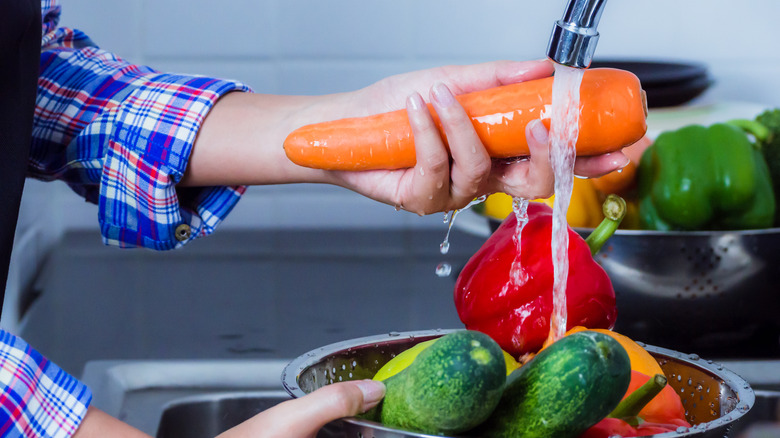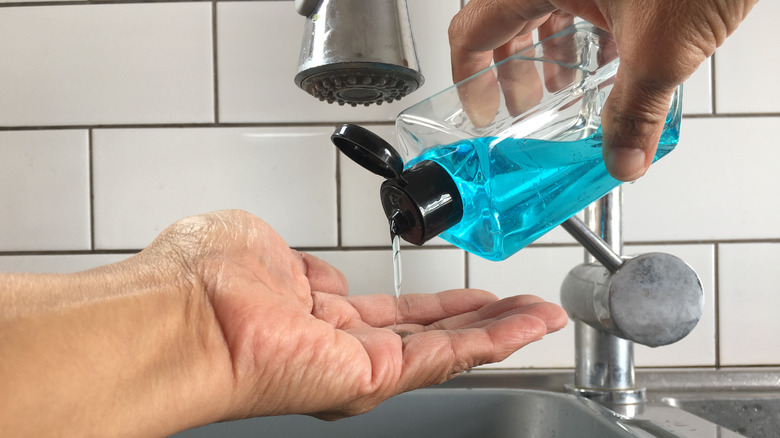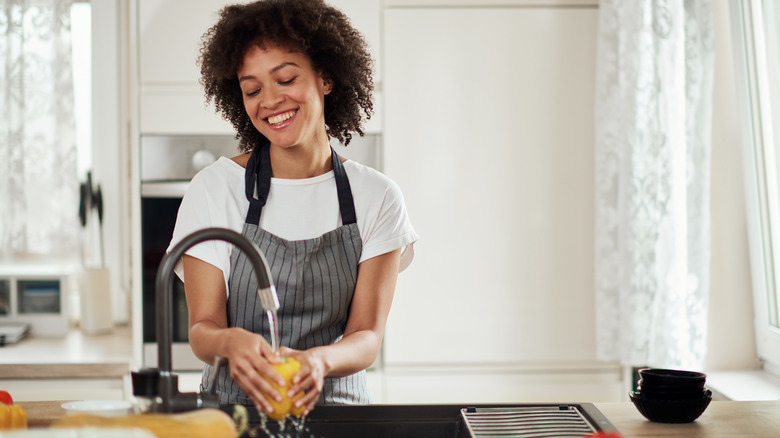Is It Safe To Use Soap To Wash Produce?
There's nothing quite like the satisfying crunch and rich flavor of fresh produce. However, without careful preparation of our fruits and veggies, we run the risk of foodborne illness. U.S. Food and Drug Administration (FDA) expert Glenda Lewis explains that while growing, produce can become exposed to animal waste and contaminated water or soil (via FDA). Ingesting germs such as E.coli, Listeria, or Salmonella through contaminated produce can lead to fever, vomiting, digestive discomfort, bloody diarrhea, and muscle aches, amongst other symptoms (via MedicalNewsToday). Among those most vulnerable to foodborne illness are young children, those who are pregnant, adults over the age of 65, and immunocompromised individuals.
For this reason, it's important to clean produce prior to cooking — this is particularly important if you're someone who enjoys eating your produce raw (via The University of Maine). While it's impossible to rid produce of germs entirely, Davis Erin DiCaprio, assistant cooperative extension specialist in community food safety at the University of California, told the New York Times that washing is still an important step in safe food preparation. Doing so can remove 90-99% of microbes, thereby reducing the risk of food poisoning.
The risks of washing produce with soap
While soap may be great for removing germs from our hands, it's not advised to use on produce. As per the Washington Post, because soap is able to be absorbed by fruits and veggies, eating produce that's been washed with soap means you are likely ingesting soap residue. Doing so can cause illness including gastrointestinal discomfort, vomiting, diarrhea, and can throw off the balance of good bacteria in the gut.
As outlined by the U.S. Department of Agriculture (via the Washington Post), consumers of produce are not advised to wash fruits and vegetables with detergent, soap, or commercial produce washes. Furthermore, these products are typically not approved or labeled by the FDA. Instead, consumers can reduce their risk for foodborne illness by taking a few simple steps and simply rinsing their produce with water prior to peeling (via the FDA). A clean vegetable scrub can be used on firm fruits and veggies.
How to properly wash your produce
Experts at the FDA offer the following guidelines: First, be sure to wash your hands for 20 seconds with warm, soapy water before handling any food. Next, remove any portions of produce that appear bruised or damaged. Then, rinse the produce under cool running water while rubbing its surface. Feel free to use a vegetable brush when handling food items with a harder exterior such as cucumbers or melons. Be sure to thoroughly dry produce with a paper towel, and store it in the fridge at a temperature of 40 degrees Fahrenheit or below.
For vegetables, specifically, the FDA advises removing the leaves on the outer layer of cabbage and lettuce heads. Additionally, according to The University of Maine, leafy greens can be repeatedly soaked for several minutes in a bowl of cool water and strained using a colander. Afterward, dry your greens with a paper towel or salad spinner. There is no need to wash produce labeled as having already been washed.
Lastly, when it comes to produce, don't forget to thoroughly wash all cooking utensils when you are done.



